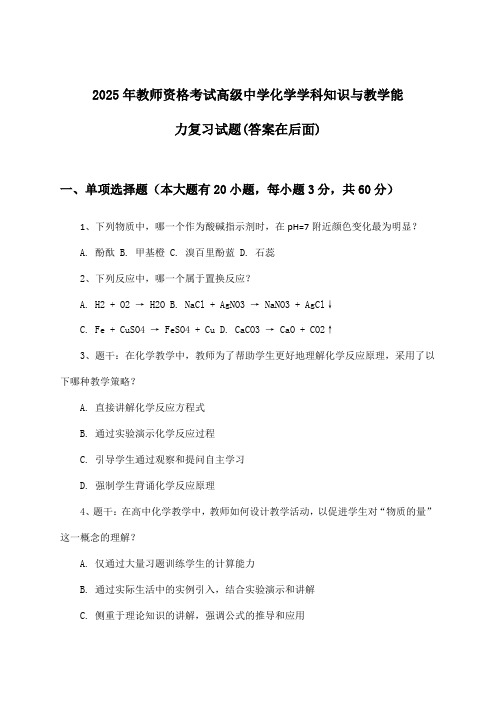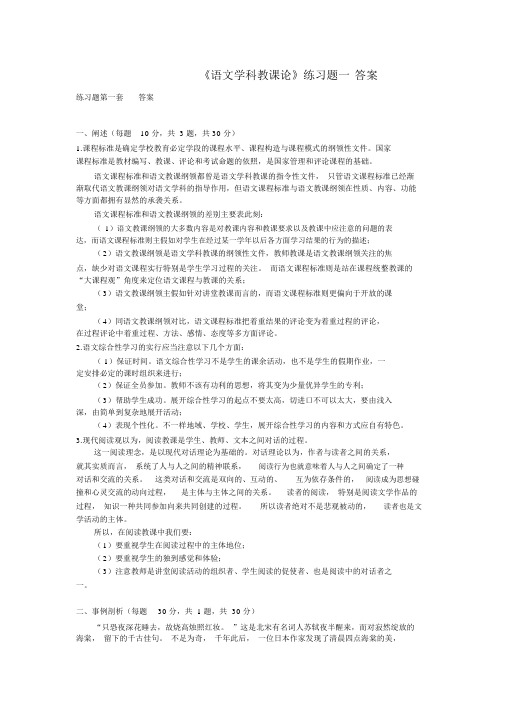学科教学法习题
教师资格考试高级中学化学学科知识与教学能力试题与参考答案(2025年)

2025年教师资格考试高级中学化学学科知识与教学能力复习试题(答案在后面)一、单项选择题(本大题有20小题,每小题3分,共60分)1、下列物质中,哪一个作为酸碱指示剂时,在pH=7附近颜色变化最为明显?A. 酚酞B. 甲基橙C. 溴百里酚蓝D. 石蕊2、下列反应中,哪一个属于置换反应?A. H2 + O2 → H2OB. NaCl + AgNO3 → NaNO3 + AgCl↓C. Fe + CuSO4 → FeSO4 + CuD. CaCO3 → CaO + CO2↑3、题干:在化学教学中,教师为了帮助学生更好地理解化学反应原理,采用了以下哪种教学策略?A. 直接讲解化学反应方程式B. 通过实验演示化学反应过程C. 引导学生通过观察和提问自主学习D. 强制学生背诵化学反应原理4、题干:在高中化学教学中,教师如何设计教学活动,以促进学生对“物质的量”这一概念的理解?A. 仅通过大量习题训练学生的计算能力B. 通过实际生活中的实例引入,结合实验演示和讲解C. 侧重于理论知识的讲解,强调公式的推导和应用D. 强调学生之间的合作,进行小组讨论和问题解决5、下列哪种物质在酸性介质中的氧化能力最强?A. K2Cr2O7B. KMnO4C. H2O2D. I26、对于反应:N2(g) + 3H2(g) ⇌ 2NH3(g),如果增加体系的压力,平衡将会如何移动?A. 向左移动B. 向右移动C. 不移动D. 先向左后向右移动7、在化学教学过程中,教师为了提高学生的学习兴趣,采用了以下哪种教学方法?()A. 演示法B. 案例分析法C. 合作学习法D. 问卷调查法8、下列关于化学实验教学的说法中,正确的是()。
A. 化学实验教学中,教师应尽量减少实验操作,让学生多观察、多思考B. 化学实验教学中,教师应注重实验结果,忽略实验过程中的操作规范C. 化学实验教学中,教师应鼓励学生独立完成实验,培养学生的创新精神D. 化学实验教学中,教师应只注重实验操作,忽视实验原理的讲解9、下列物质中,属于金属单质的是()A. 氯化钠B. 氢气C. 氧气D. 铜丝 10、在下列化学反应中,不属于置换反应的是()A. 2H2 + O2 → 2H2OB. Fe + CuSO4 → FeSO4 + CuC. 2KClO3 → 2KCl + 3O2↑D. Zn + H2SO4 → ZnSO4 + H2↑11、在下列化学反应中,属于放热反应的是()A. 2H₂O₂ → 2H₂O + O₂B. 2HCl + 2NaOH → 2NaCl + 2H₂OC. N₂ + 3H₂ → 2NH₃D. CaCO₃ → CaO + CO₂12、在下列物质中,属于酸的是()A. 氢氧化钠(NaOH)B. 氯化钠(NaCl)C. 硫酸(H₂SO₄)D. 氧化钙(CaO)13、在下列物质中,属于纯净物的是()A. 空气B. 氯化钠溶液C. 纯碱D. 水玻璃14、下列关于化学反应速率的说法正确的是()A. 反应速率越快,反应越完全B. 增大反应物的浓度,反应速率一定增加C. 降低温度,反应速率一定减慢D. 增加反应物的接触面积,反应速率一定增加15、在下列化学反应中,不属于置换反应的是:A. 2HCl + Zn → ZnCl2 + H2↑B. Fe + CuSO4 → FeSO4 + CuC. 2KClO3 → 2KCl + 3O2↑D. 4NH3 + 5O2 → 4NO + 6H2O16、下列关于化学实验安全操作的描述,错误的是:A. 在实验室内禁止吸烟,以防火灾B. 实验室中的药品不能随意混合,以防发生危险C. 在实验室内禁止使用明火,以防爆炸D. 在进行易燃气体实验时,应先将气体排空,再进行实验17、在下列化学实验操作中,属于正确操作的是()A. 向试管中倾倒液体药品时,试管口紧贴试剂瓶口,防止药品洒落B. 用胶头滴管滴加液体时,滴管应悬空正放,避免污染药品C. 在进行试管加热实验时,试管底部应与火焰接触,使试管均匀受热D. 使用天平时,将待称物质直接放在天平托盘上,无需使用称量纸18、在下列化学反应中,不属于置换反应的是()A. 2H2 + O2 → 2H2OB. Zn + 2HCl → ZnCl2 + H2↑C. Fe + CuSO4 → FeSO4 + CuD. CaCO3 → CaO + CO2↑19、在化学实验中,以下哪种仪器用于精确测量溶液的体积?A. 量筒B. 容量瓶C. 烧杯D. 滴定管 20、在下列化学反应中,哪种类型的反应不属于氧化还原反应?A. 2H₂ + O₂ → 2H₂OB. Fe + CuSO₄ → FeSO₄ + CuC. 2KClO₃ → 2KCl + 3O₂D. H₂SO₄ + Ba(OH)₂ → BaSO₄ + 2H₂O二、简答题(本大题有2小题,每小题12分,共24分)第一题请简述化学教学中的实验探究教学策略,并举例说明如何在高中化学教学中应用这些策略。
语文学科教学论练习题答案语文学科教学论答案

《语文学科教课论》练习题一答案练习题第一套答案一、阐述(每题10 分,共 3 题,共 30 分)1.课程标准是确定学校教育必定学段的课程水平、课程构造与课程模式的纲领性文件。
国家课程标准是教材编写、教课、评论和考试命题的依照,是国家管理和评论课程的基础。
语文课程标准和语文教课纲领都曾是语文学科教课的指令性文件,只管语文课程标准已经渐渐取代语文教课纲领对语文学科的指导作用,但语文课程标准与语文教课纲领在性质、内容、功能等方面都拥有显然的承袭关系。
语文课程标准和语文教课纲领的差别主要表此刻:(1)语文教课纲领的大多数内容是对教课内容和教课要求以及教课中应注意的问题的表达,而语文课程标准则主假如对学生在经过某一学年以后各方面学习结果的行为的描述;(2)语文教课纲领是语文学科教课的纲领性文件,教师教课是语文教课纲领关注的焦点,缺少对语文课程实行特别是学生学习过程的关注。
而语文课程标准则是站在课程统整教课的“大课程观”角度来定位语文课程与教课的关系;(3)语文教课纲领主假如针对讲堂教课而言的,而语文课程标准则更偏向于开放的课堂;(4)同语文教课纲领对比,语文课程标准把着重结果的评论变为着重过程的评论,在过程评论中着重过程、方法、感情、态度等多方面评论。
2.语文综合性学习的实行应当注意以下几个方面:( 1)保证时间。
语文综合性学习不是学生的课余活动,也不是学生的假期作业,一定安排必定的课时组织来进行;(2)保证全员参加。
教师不该有功利的思想,将其变为少量优异学生的专利;(3)帮助学生成功。
展开综合性学习的起点不要太高,切进口不可以太大,要由浅入深,由简单到复杂地展开活动;(4)表现个性化。
不一样地域、学校、学生,展开综合性学习的内容和方式应自有特色。
3.现代阅读观以为,阅读教课是学生、教师、文本之间对话的过程。
这一阅读理念,是以现代对话理论为基础的。
对话理论以为,作者与读者之间的关系,就其实质而言,系统了人与人之间的精神联系,阅读行为也就意味着人与人之间确定了一种对话和交流的关系。
教师资格考试初级中学学科知识与教学能力数学试题与参考答案

教师资格考试初级中学数学学科知识与教学能力复习试题(答案在后面)一、单项选择题(本大题有8小题,每小题5分,共40分)1、在下列数学概念中,属于集合论基础概念的是()A. 函数B. 数列C. 集合D. 比例2、在平面直角坐标系中,点P(3,4)关于直线y=x的对称点是()A. (4,3)B. (3,4)C. (-4,-3)D. (-3,-4)3、题干:在三角形ABC中,已知AB=AC,角B的度数为60°,那么角A的度数是()A. 60°B. 120°C. 30°D. 90°4、题干:下列关于函数y = x² - 4x + 3的描述,不正确的是()A. 函数图像是开口向上的抛物线B. 函数图像的对称轴是x = 2C. 函数图像与x轴的交点坐标为(1, 0)和(3, 0)D. 函数图像的顶点坐标是(2, -1)5、在平面直角坐标系中,点A的坐标为(3,2),点B的坐标为(-1,5)。
若点C 在直线y=2x上,且三角形ABC是等腰三角形,则点C的坐标可能是:A、(1,2)B、(-2,-4)C、(-1,4)D、(2,4)6、函数f(x) = 3x² - 4x + 5的图像是一个:A、开口向上的抛物线,顶点在x轴上B、开口向下的抛物线,顶点在x轴上C、开口向上的抛物线,顶点在y轴上D、开口向下的抛物线,顶点在y轴上7、在下列数学概念中,不属于平面几何范畴的是:A. 直线B. 圆C. 空间四边形D. 点8、以下关于函数概念的说法中,正确的是:A. 函数是一种关系,但不一定是数学关系B. 函数是一种对应关系,其中每个自变量值对应唯一的一个因变量值C. 函数是一种运算,但不一定是数学运算D. 函数是一种物理量,与自变量和因变量无关二、简答题(本大题有5小题,每小题7分,共35分)第一题请结合教学实践,阐述如何在初中数学教学中培养学生的逻辑思维能力。
《小学学科教学论》 期末考试复习题

小学学科教学论期末考试复习题一、单项选择题1.质性研究的理论基础是()。
A.解释主义B.实证主义C.实验主义D.现实主义正确答案:A【答案解析】质性研究的理论基础是解释主义。
参见教材P34。
本题知识点:研究方法类型下的幼儿园教师研究。
2.量化研究的理论基础是()。
A.解释主义B.实证主义C.实验主义D.现实主义正确答案:B【答案解析】量化研究的理论基础是实证主义。
参见教材P34。
本题知识点:研究方法类型下的幼儿园教师研究。
3.关于广义的学前教育研究视野,下列说法错误的是()。
A.包括托幼机构中的所有教育现象B.包括家庭、社区、国家、社会关涉学前教育的经济、政治、文化、制度、思想、观念、行为方式等方面C.包括3岁以前的婴幼儿、新生儿、胎儿等所有的教育问题D.学前教育研究的内容都是微观的正确答案:D【答案解析】学前教育研究的内容广泛而深刻,既有宏观又有微观,既有基础性又有应用性,既有社会性又有个体性。
参见教材P31。
本题知识点:研究方法类型下的幼儿园教师研究。
4.学前教育研究的方法,依据研究有无控制性,将方法分为()。
A.经验法与实验法B.历史法、描述法和实验法C.实验室研究和自然研究D.观察法、调查法正确答案:A【答案解析】依据研究有无控制性,将方法分为两类,即经验法与实验法。
参见教材P35。
本题知识点:研究方法类型下的幼儿园教师研究。
5.依据研究场所的不同,将学前教育研究的方法分为()。
A.经验法与实验法B.历史法、描述法和实验法C.实验室研究和自然研究D.观察法、调查法正确答案:C【答案解析】依据研究场所的不同,将方法分为实验室研究和自然研究。
参见教材P35。
本题知识点:研究方法类型下的幼儿园教师研究。
6.学前教育研究方法的最高层次为()。
A.方法论B.具体研究方法C.一般方法D.指导方法正确答案:A【答案解析】学前教育研究方法的最高层次为方法论。
参见教材P32。
本题知识点:研究方法类型下的幼儿园教师研究。
《小学语文教学法》习题与答案

《小学语文教学法》习题与答案(解答仅供参考)一、名词解释:1. 语文教学法:语文教学法是一门研究小学阶段语文教学的理论与实践方法的学科,它主要探讨如何有效地教授汉字、词语、句子、篇章等语文知识,培养学生的听说读写能力以及语言运用、思维品质和文化素养。
2. 启发式教学法:启发式教学法是指在语文教学过程中,教师通过创设情境、提出问题等方式,引导学生主动思考、探索问题的答案,从而激发学生的学习兴趣和积极性,培养其独立思考和解决问题的能力的教学方法。
3. 情境教学法:情境教学法是在小学语文教学中,教师根据教学内容创设生动具体的场景或环境,使学生仿佛置身其中,通过直观感知、情感体验等方式理解和掌握知识,提高学习效果的一种教学方法。
4. 分层教学法:分层教学法是针对班级内学生语文水平差异较大的情况,教师按照学生的实际能力和需求将教学内容、教学目标和教学方法进行分层次设计和实施,以满足不同层次学生的学习需要,促进全体学生的共同进步。
5. 微型写作:微型写作是一种短小精悍的写作训练形式,在小学语文教学中常用于培养学生的基础写作能力。
通常要求学生围绕特定主题或情境,用简洁的语言完成一段话或几句话的表达,以此锻炼学生的语言组织和表达能力。
二、填空题:1. 小学语文教学应遵循“以学生为主体,_______”的基本原则。
答案:以教师为主导2. 语文课程标准强调,小学阶段要注重培养学生热爱祖国语言文字的情感,养成良好的_______。
答案:语感3. 在识字教学中,常用的“字理识字法”是通过对汉字的_______和构造原理进行解析,帮助学生理解并记忆汉字。
答案:字源4. 阅读教学应注重引导学生在阅读中积累语言材料,感受文本所传递的情感,体会作者的思想感情,初步掌握_______的方法。
答案:阅读策略5. 写作教学应当从观察生活、积累素材开始,逐步教会学生运用恰当的语言文字进行表达,形成_______的意识。
答案:书面交际三、单项选择题:1. 下列哪种教学法主张让学生通过直接经验获取知识?A. 讲授法B. 实践操作法C. 讨论法D. 演示法答案:B. 实践操作法2. 语文课程标准倡导开展整本书阅读,旨在:A. 培养学生的快速阅读技能B. 提高学生的课外阅读量,丰富文化底蕴C. 强化对教材课文的理解D. 提升学生的文学鉴赏能力答案:B. 提高学生的课外阅读量,丰富文化底蕴3. 对于低年级的学生,采用复述故事的方式进行口语交际训练,主要目的是:A. 锻炼学生的记忆力B. 培养学生的创新思维C. 提高学生的语言组织能力和口头表达能力D. 激发学生的阅读兴趣答案:C. 提高学生的语言组织能力和口头表达能力4. 在作文批改中,以下哪项做法符合“鼓励性评价”的原则?A. 只指出错误,不提优点B. 主要批评学生的语法错误C. 全面评价,既指出不足也肯定进步和亮点D. 只给出分数,不作具体评语答案:C. 全面评价,既指出不足也肯定进步和亮点5. 教师在指导学生朗读时,不仅要关注语音、语调的准确性,还要重视______的培养。
基础的教育学与教学法试题和答案

基础的教育学与教学法试题和答案
试题一
1. 什么是教育学?
2. 教育学的研究对象是什么?
3. 请列举教育学的主要分支领域。
答案一
1. 教育学是研究教育现象、规律和方法的学科。
2. 教育学的研究对象是教育。
3. 教育学的主要分支领域包括教育心理学、教育社会学、教育经济学、教育管理学等。
试题二
1. 什么是教学法?
2. 教学法的研究内容包括哪些方面?
3. 请列举几种常见的教学法。
答案二
1. 教学法是指教师在教学过程中所采用的方法和策略。
2. 教学法的研究内容包括教学目标的确定、教学内容的选择与
组织、教学方法的设计、教学过程的管理等方面。
3. 常见的教学法包括讲授法、讨论法、实验法、案例法、问题
解决法等。
试题三
1. 教育学和教学法的关系是什么?
2. 为什么教育学与教学法的研究对教师的教学实践具有重要意义?
答案三
1. 教育学是教学法的理论基础,教学法是教育学在实践中的具
体应用。
2. 教育学和教学法的研究可以帮助教师深入理解教育的本质和
规律,指导教师更科学地开展教学活动,提高教学效果。
同时,教
育学和教学法的研究也有助于教师不断反思和改进自己的教学方法,适应不同学生的需求和特点。
2022年-2023年教师资格之中学音乐学科知识与教学能力练习题(二)及答案

2022年-2023年教师资格之中学音乐学科知识与教学能力练习题(二)及答案单选题(共40题)1、大二度的下方音降低变化全音则变成()。
A.大三度B.增三度C.倍减二度D.倍增二度【答案】 D2、表现主义音乐最基本的表现手法是()。
A.主调音乐B.复调音乐C.无调性音乐D.有调性音乐【答案】 C3、用于肾阴亏虚而致肝阴不足、肝阳偏亢之证的是A.益火补土法B.金水相生法C.抑木扶土法D.滋水涵木法E.培土生金法【答案】 D4、下列柴科夫斯基的作品中,与其他三项类型不同的是( )。
A.《黑桃皇后》B.《天鹅湖》C.《睡美人》D.《胡桃夹子》【答案】 A5、下列作品中属于贝多芬的代表作的是()。
A.《C小调第九交响曲》B.《C小调练习曲》C.歌剧《自由(魔弹)射手》D.歌剧《费德里奥》【答案】 D6、作曲家施光南根据鲁迅的文学作品()创作了一部同名歌剧,并于1981年首演。
A.《伤逝》B.《祝福》C.《孔乙己》D.《狂人日记》【答案】 A7、下列属于隋唐时期作品的是()A.《碣石调·幽兰》B.《霓裳羽衣曲》C.《杏花天影》D.《海青拿天鹅》【答案】 B8、教师在讲授《青春舞曲》时,为了激发学生的学习兴趣,增强学习氛围。
在整体聆听后,教师请学生结合歌曲进行声势练习。
在教学过程中,该教师主要运用了哪种音乐教学法?()A.达尔克罗兹教学法B.奥尔夫教学法C.日本铃木镇一音乐教学法D.柯达伊教学法【答案】 B9、创作有歌曲《游击队歌》和管弦乐小品《森吉德玛》等音乐作品的我国音乐家是()。
A.贺绿汀B.丁善德C.冼星海D.杜鸣心【答案】 A10、下列乐曲中属于阿炳创作的琵琶曲是()。
A.《欢乐歌》B.《三六》C.《大浪淘沙》D.《行街》【答案】 C11、流行于浙江地区的戏曲是( )A.花鼓戏B.黄梅戏C.采茶戏D.越剧【答案】 D12、女性患儿,10岁,因发热、头痛、喉痒、咳嗽3天到儿科门诊治疗,经诊断为上呼吸道感染。
学科教学基础考研真题

学科教学基础考研真题
学科教学基础是考研教育学专业的一门重要课程,对于考生来说,熟悉并掌握考试内容以及解题技巧是非常关键的。
本文将为大家提供一些学科教学基础考研真题,希望能够对大家备考有所帮助。
一、选择题
1. 哪个理论对于解决学习困难儿童问题作出了重要贡献?
A. 行为主义理论
B. 心理分析理论
C. 社会认知理论
D. 惯性学习理论
2. 在学科教学中,教师的职责是?
A. 传授知识
B. 激发学生学习兴趣
C. 提供学习资源
D. 批判学生的错误观念
3. 根据布鲁姆分类系统,以下哪个属于高级认知目标?
A. 理解
B. 记忆
C. 应用
D. 接受
二、判断题
1. 教学设计要求满足学生不同的学习需要,因此可以忽略个别学生的需求。
A. 正确
B. 错误
2. 建构主义教育理念强调学生和教师通过互动合作实现教育目标。
A. 正确
B. 错误
三、简答题
1. 请简要解释一下多元智能理论。
2. 请列举几个能够提高课堂参与度的方法。
四、论述题
请简要论述一下在学科教学中如何培养学生的创新能力。
以上题目仅为参考,实际考试题目可能会有所变化。
在备考学科教学基础考研时,建议广泛阅读相关教材和参考书籍,掌握基础知识,
并多做题进行巩固。
同时,也要在解答题目时注意论述的条理清晰和语言表达的准确性。
希望以上内容能够对正在备考学科教学基础考研的考生有所帮助,祝愿大家都能取得优异的成绩!。
- 1、下载文档前请自行甄别文档内容的完整性,平台不提供额外的编辑、内容补充、找答案等附加服务。
- 2、"仅部分预览"的文档,不可在线预览部分如存在完整性等问题,可反馈申请退款(可完整预览的文档不适用该条件!)。
- 3、如文档侵犯您的权益,请联系客服反馈,我们会尽快为您处理(人工客服工作时间:9:00-18:30)。
(一)体育课程的概念和特点是什么?1、体育课程就是指以发展学生体能,增进学生身心健康为主的一种特殊的教学课程,它与德育课程、智育课程、美育课程、劳动教育课程相配合,共同促进学生身心的全面发展,是整个学校教育的一个方面的课程。
2、体育课程的特点:1)运动认知性课程:主要是通过人体本体感觉形成的认知。
(运动活动与身体练习)2)生活教育课程:主要是为了学生能快乐、健康、幸福地生活,感受人的生命力,体验情感,增强意志力服务。
3)情意性课程:是通过课程体验来改造人的主观世界。
发展人的情感、情绪、态度、价值,特别是意志力。
4)综合性课程:涉及体育、生理卫生、健康、环境、娱乐、人际关系、运动技能、技巧。
(二)体育课程价值是什么?1.增进身体健康 2.提高心理健康水平 3.增强社会适应能力 4.获得体育与健康知识和技能(三)体育课程的基本理念是什么1、坚持“健康第一”的指导思想,促进学生健康成长,培养学生健康的意识和体魄2、激发运动兴趣,培养学生终身体育的意识3、以学生发展为中心,重视学生的主体地位,帮助学生学会学习4、关注个体差异与不同需求,确保每一个学生受益,注重学生运动爱好和专长的形成5、改革课程内容与教学方式,努力体现课程的时代性(四)体育课程的目标是什么?1、增强体能,掌握和应用基本的体育与健康知识和运动技能;2、培养运动的兴趣和爱好,形成坚持锻炼的习惯;3、具有良好的心理品质,表现出人际交往的能力与合作精神;4、提高对个人健康和群体健康的责任感,形成健康的生活方式;5、发扬体育精神,形成积极进取、乐观开朗的生活人生态度。
(五)体育课程的功能是什么?1、培养学生具有健康的体魄2、促进学生运动爱好和专长的形成,奠定学生终身体育的基础3、培养健全人格,促进心理健康4、培养团队合作和竞争精神,提高社会适应能力5、以学生发展为中心,帮助学生学会体育学习6、培养国际意识和民族意识(六)体育教学内容的特点是什么? 1、身体运动性 2、健身性 3、娱乐性 4、非阶梯性(七)论述田径运动技术教学的意义和任务?1、田径运动技术教学的意义:○1田径运动是各项体育运动的基础,它是由走跑类、跳跃类、投掷类项目和全能项目组成的。
通过田径运动技术的教学,掌握基本技术,提高学生各项身体素质和体育技能。
○2田径运动各项技术有着自身的特点和理论基础。
○3田径运动项目多,技术各有不同。
2、田径运动技术教学的任务:○1进行田径运动各项技术的教学,使学生学习和掌握田径运动的各项技术。
○2提高各项身体素质,达到增强体质的目的。
○3提高学生田径运动理论知识水平和认识能力。
○4加强人的素质培养,充分利用项目的特点,培养学生的优秀品质。
○5传授各项技术的教学方法。
(八)试述田径运动中任一项目的教学重点、难点、方法、手段及错误动作的纠正?答:以短跑为例:1、短跑技术教学的重点:1)跑的专门性练习。
2)短跑途中跑。
3)短跑起跑技术。
4)弯道跑技术和接力跑技术。
2、短跑技术教学的难点:1)途中跑的技术规格。
2)跑的放松技术。
3)起跑技术。
3、短跑技术教学的方法和手段○1介绍短跑完整技术,使学生对短跑技术有初步的了解。
第一、讲解短跑的发展概况、项目特点和短跑基本技术第二、短跑技术示范第三、观看优秀运动员的技术图片、录像○2进行跑的专门练习○3学习直道途中跑技术○4学习加速跑技术○5学习蹲踞式起跑技术○6学习弯道途中跑和弯道跑技术○7学习终点跑和全程跑的技术○8学习不同距离短跑的全程节奏4、短跑技术教学中的错误及纠正方法○1摆动腿前摆时高抬腿技术差○2摆臂紧张,前后摆幅不均,向外偏○9不撞线或跳起撞线○3跑步时没有小腿和脚的后摆下压扒地动作○4坐着跑,只抬腿不送髋○5抢跑○6加速跑中过早抬体,减弱了加速质量○7蹬离起跑器无力○8终点跑后蹬角度过大,向上跳着跑以跨栏项目为例:1、起跨点离栏架远,摆动腿膝高抬,上体积极前倾,下压积极有力。
2、跨栏的发展趋势(1)速度是提高跨栏成绩的主要因素。
(2)高重心,快频率。
(3)提高跨栏专项周期速度。
(4)过栏技术要重视改进下栏技术。
(5)跨栏跑技术的发展:运动员的身高和平跑速度快。
3、跨栏技术教学的重点:(1)起跑至第一栏技术教学。
(2)跑跨结合。
(3)跨栏步技术。
4、跨栏技术教学的难点: ○1提高柔韧性○2跨栏步和下栏后的身体平衡○3“跨栏步”和栏间跑的衔接5、跨栏技术教学的方法和手段突出了跑跨结合的能力,以先教栏间跑为主,在教学方法上也采用了先完整后分解,以提高学生的跑跨能力。
当学生体会了跨栏跑的正确动作路线后便可直接过栏。
(1)建立跨栏跑的完整技术概念(2)学习跨栏步技术(3)学习栏前跑和跨越第一栏技术(4)学习过栏和栏间跑相结合的技术(5)学习起跑后的过栏技术(6)改进全程跨栏跑完整技术6、跨栏技术教学中学生常出现的错误及纠正方法1)起跨消极,身体重心低,蹬地不充分,屈腿跳栏。
2)跳栏。
3)摆动腿直腿过栏或盘腿绕栏。
4)腾空后两腿动作消极“剪绞”幅度小速度慢。
5)下栏时身体失去平衡,动作停顿。
6)栏间跑身体重心低脚掌缺乏弹性。
7)栏间跑第一步太小,影响栏间跑的节奏。
8)栏间跑直线性差。
9)起跨点不准确、不积极。
10)全程跑节奏不稳以跳高项目为例:1、背越式跳高技术教学的重点:(1)助跑和起跳的结合。
(2)起跳技术。
(3)弧线助跑。
2、背越式跳高技术教学的难点:(1)蹬摆配合技术。
(2)杆上动作。
(3)适宜的起跳点。
3、背越式跳高技术教学的方法和手段1)建立正确的技术概念 2)学习背越式跳高的辅助练习 3)学习和掌握起跳技术4)学习和掌握助跑技术 5)掌握助跑和起跳相结合技术 6)学习、掌握过杆和落地技术7)掌握起跳和过杆相结合技术 8)掌握助跑—起跳—过杆相结合技术4、背越式跳高技术教学中学生常出现的错误及纠正方法1)起跳常见错误动作。
2)弧线助跑中常见错误动作。
3)过杆落地时常见错误动作。
(4)跳高技术教学中应注意的事项。
以铅球为例:1、铅球技术教学的重点:1)完整技术教学。
2)重视施力于器械的准确性。
3)协调的用力形式。
2、铅球技术教学的难点:1)持球滑步技术。
2)完整技术教学。
3)左侧支撑技术。
3、铅球技术教学的方法和手段1)建立正确的铅球技术概念(2)学习和掌握铅球技术的诱导性练习(3)学习握球和持球方法4)学习推铅球最后用力技术(5)原地侧向推铅球(6)原地背向推铅球7)学习背向滑步推铅球技术(8)改进背向滑步推铅球技术4、铅球技术教学中学生常出现的错误及纠正方法○1握球时满把抓并将球托在肩上或离开颈部。
○2团身动作不到位,右膝弯曲不够,重心偏高。
○3团身时上体前屈不够。
○6滑步结束,体重没有落在弯曲的右腿支撑点附近;肩轴与髋轴失去扭紧。
○4滑步时蹬、摆动动作幅度小,滑步距离短。
○8最后用力时,上体前屈,臀部后坐,只靠上肢发力。
○5滑步时上体抬起,左臂后摆。
○7滑步与最后用力衔接不好。
○9推球时左肩后撤或上体向左倒。
○10推球跳起过早,形成无支撑推球。
○11完整技术的节奏不好。
(九)田径运动技术教学方法是什么?1.形成动作技能的规律:1)粗略掌握阶段(泛化) 2)改进提高阶段(分化) 3)熟练巩固阶段(自动化)2.教学方法:1)完整教学法2)分解教学法3)程序教学法4)发现教学法5)系统教学法6)模块教学法(十)田径运动技术教学错误动作和伤害产生原因1.错误动作的产生:1)对技术动作概念不清楚 2)身体素质较差 3)思想过度紧张或客观条件的影响2.伤害事故的产生1)自我伤害:一般是准备活动不充分,技术概念不清,而用力过猛,身体过于疲劳,场地器材使用不当,注意力不集中,不遵守安全规范等。
2)互相误伤:注意力不集中,不按照练习顺序及方向,忽视安全措施及不遵守课堂常规纪律,从而碰撞了同学。
二、简答题1、试述技巧后滚翻的教法和保护方法。
教法:①两手放在肩上方,做向后滚动手撑地。
②用斜面由高到低做后滚。
③肩主动后倒,快速举腿,以顺利翻转完成动作。
保护方法:保护者单腿跪立在学员侧后方,一手托肩,一手推背,助其翻转。
2、体操教法有哪些,其中示范法的种类有几种。
①直观法、②语音法、③练习法、④游戏法、⑤比赛法①完整法、②分解法、③慢速法、④对比法、⑤领做法3、运用示范法时应注意的问题?1)有明确的目的; 2)动作正确、熟练; 3)便于学生观察; 4)启发学生思维相结合. 4、技能迁移教学法一般有几种情况?在体育教学中,最常用的是哪种?技能迁移教学法一般有两种情况,分别是:正迁移和负迁移。
在体育教学中,最常用的是:动作迁移。
5、在运用情景教学法时,如何运用语言艺术?答:情景教学中,体育教师语言表达能力的强弱,教学生动与否,会直接影响学生对情景的理解以及学生的心理定势、情感变化和学习兴趣。
体育教师应根据情景教学的特点来运用语言艺术,力求在语言表达上更加具有艺术性,增强语言的感染力,收到良好的教学效果。
所以应该做到以下几点:○1语言表达要准确、简明。
○2语言要具有幽默性和调节性。
○3在不同的情景下,语言要有不同的诱导性、比喻性和启发性。
6、试述体操教学和体操教学原则。
体操教学是教师向学生传授体操知识、技术和技能,培养学生良好思想品质的教育过程。
体操教学原则:①素质先导性、②技能整体性、③安全性、④审美性原则7、举三例典型的研究性学习教学案例.说出其研究的目的.答: 1.侧向滑步推实心球。
研究目的:启发学生利用所学过的力学知识,分析实心球的受力原理,思考如何才能让实心球飞得更远。
2.跨栏跑。
研究目的:克服跨栏跑中学生怕摔伤的恐惧心理,开动脑筋,发挥学生的创造性,从而寻求用其他物体来代替栏杆。
在练习过程中按思--练--思的程序反复练习,练完后再找出其成功和失败的原因,通过实践从理性上认识跨栏跑,体验运动乐。
3.弯道跑。
研究目的:通过学生们亲身体会弯道跑时克服离心力所做的运动,来进一步的让学生们去总结:如何利用所学过的圆周运动的知识去更好的改正和发展弯道跑的动作要领。
8、在体育教学中,如何来提高练习密度和运动负荷提高练习密度的方法七点:1.尽可能采用全班或分组讲解示范2.采用循环练习法3补充练习或加强素质内容4复习课采用游戏或竞赛法5严格要求6精讲多练7合理布置场地器材提高运动负荷的方法有:增加练习数量 2提高练习强度 3增强练习密度 4延长练习时间5提高练习的动作质量9、体育教学设计的基本内容及要求体育教学的基本内容包括以下五点1、教学目标 2、教材与学情分析 3、教学方法 4、教学环节与过程 5、课时分配与课后延伸要求有十点:1对教材和学情进行分析;2制订教学目标明确到位;3准确把握教学重点和教学难点;4教学设想思路清晰;5教学过程规范流畅;6运用的教法、学法得当;7合理利用教学资源;8场地器材布局合理;9预测教学目标达成情况适度;10能关注学生的可持续发展。
